Can I Password Protect A Folder In Windows 10
Use encryption to password protect a binder or a file
The nigh straightforward fashion to encrypt your folders (and all the files in them) is to utilise Windows' built-in folder encryption. Here's how to encrypt a file or folder in Windows eleven, ten, 8, or seven:
-
Navigate to the folder or file you desire to encrypt.
-
Correct-click on the item, click Backdrop, so click Avant-garde.
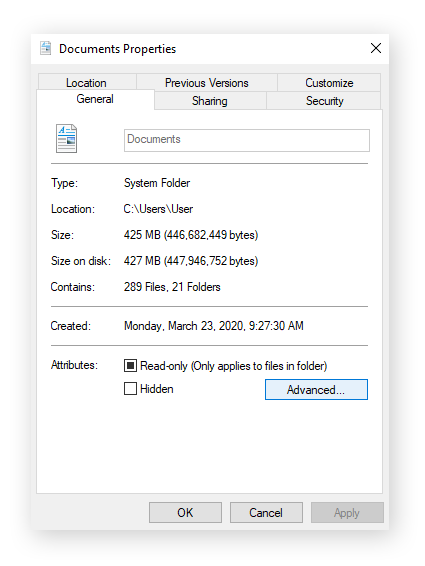
-
Check Encrypt contents to secure data. Click OK, and then click Apply.
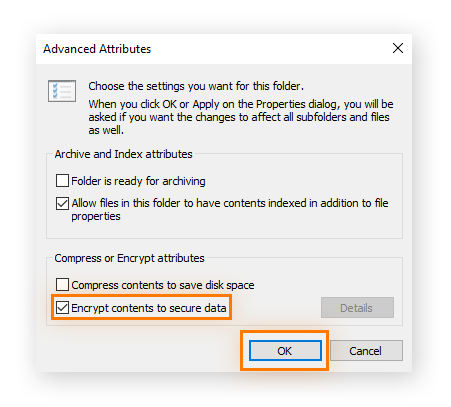
-
Windows and then asks if y'all desire to encrypt just the file or its parent binder and all the files within that too. Opt for full-folder encryption to be safe.
-
Then, when you navigate to the encrypted folder, you'll run into a pocket-sized yellow lock on the file icon. When you add new content to that folder, it will automatically be encrypted as well.

Windows file encryption protects your files confronting anyone who gets their hands on your computer. The encryption is tied to your Windows account, so when y'all're logged in, the operating system automatically decrypts your files. If someone were to log in through another business relationship, they wouldn't be able to access files that were encrypted under your username.
Merely since your files are accessible through your account, if someone gets unauthorized access to your calculator while you lot're logged in, this encryption is useless. This is where a strong login password tin can continue y'all safety.
Regular Windows encryption will accept you only so far, because it's easy to become around it by gaining access to your user account. If a cybercriminal manages to hack your account or obtain your password, they'll take total access to your files.
Keep your information safe with Avast BreachGuard. If your passwords or other personal information are ever leaked online, BreachGuard will warn you ASAP. That way, you can regain command of your accounts before anyone has the chance to log in with your credentials.
Employ password protection software
Unlike Windows' ain file encryption engineering, third-party countersign protection bars access to files and folders regardless of which user account is logged in. These tools offer more than security than congenital-in Windows security features and are highly recommended for sensitive information.
Password protect folders in Windows x and 11
Binder Lock is one content protection feature for Windows worth looking at. Folder Lock makes information technology easy to put a countersign on a folder, and it can password protect and encrypt files and folders at blazing speeds. The software uses Advanced Encryption Standard (AES) 256-flake keys to keep your data safe — the same level of encryption yous'll find with many powerful VPNs, similar Avast SecureLine VPN.
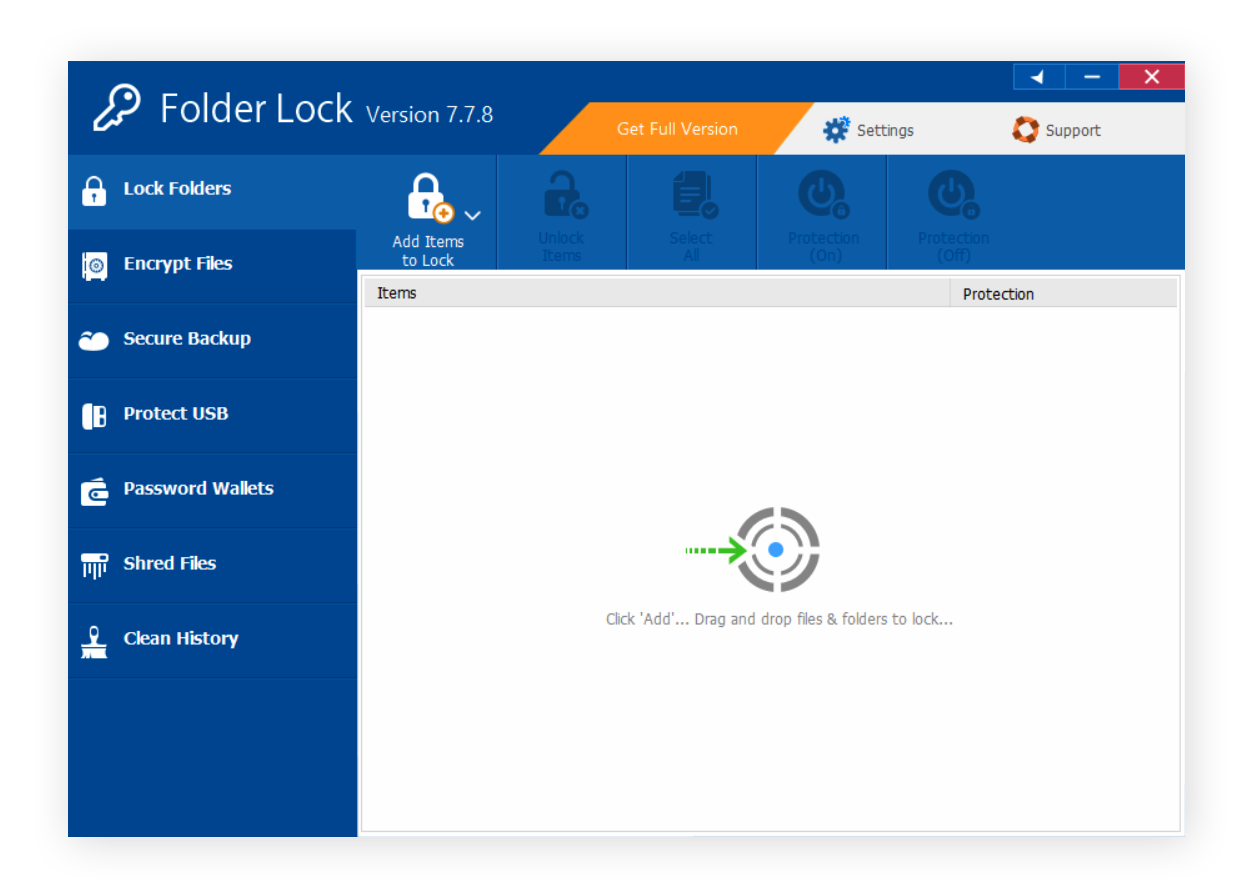
Folder Lock uses a main password to control locked content. You tin also create a "Locker," a secured folder on the drive to business firm specified content. And y'all can assign a unique password and configure the maximum deejay space for each Locker.
Folder Lock comes with a powerful file shredder and a deject-based fill-in solution as well. The demo is gratuitous, while the total-version is $39.95.
Password protect folders in Windows 7 & 8
My Lockbox is a lightweight utility with an easy-to-use interface that works for Windows XP, Vista, and Windows 7 — it's as well uniform with Windows 10 and 11. Later on installation, the tool volition ask you to ready a location for your locked folder.
All locked folders will be subconscious on your drive until y'all unlock them. My Lockbox is free and resource-light, making it an ideal solution for older computers or operating systems.
Passwords are almost always the weakest link in a security concatenation. A countersign force checker tin can be of great use hither. Online resources similar The Password Meter and my1login are skilful tools.
While stiff countersign protection will be enough for nearly users, if y'all take sensitive data, then more advanced methods such as third-party encryption tools can be used to safeguard data.
Use full encryption software to secure files and folders
Across regular password protection, yous can also apply disk-encryption software that offers more robust security. Full-encryption tools block even the near avant-garde common cold-boot and animate being-forcefulness attacks, which attempt to crack passwords and encryption keys using unlike combinations.
7-Zip
7-Zip is free, open source software that tin exist used on any figurer, and virtually any Windows system. It is essentially a file archiver that uses loftier compression and stiff AES-256 encryption.
Your files are compressed and encrypted, and then when you go to access them, you lot simply need to decompress the file first. Yeah, it's an extra stride, simply a small price to pay for high security. To secure your data with 7-Zero, follow these steps:
-
Download the latest version of 7-Nada and install it.
-
In your Windows directory, select seven-Nada File Manager.
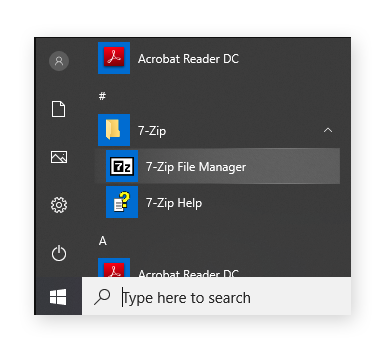
-
From the vii-Zilch control panel, select the file or binder you'd similar to protect and click the Add button.
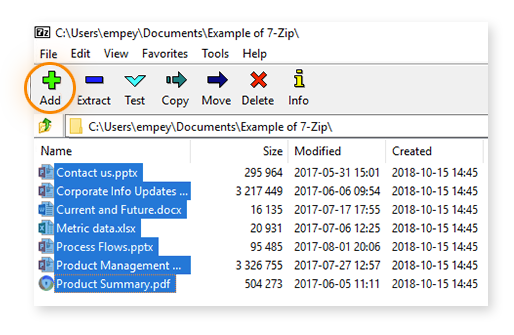
-
Choose your compression options (see image below).
-
Enter the name for your encrypted file.
-
Under the Encryption section, gear up a strong countersign for encrypting and decrypting.
-
We recommend setting your compression level to HIGH and your compression method to AES-256.
-
Click OK.
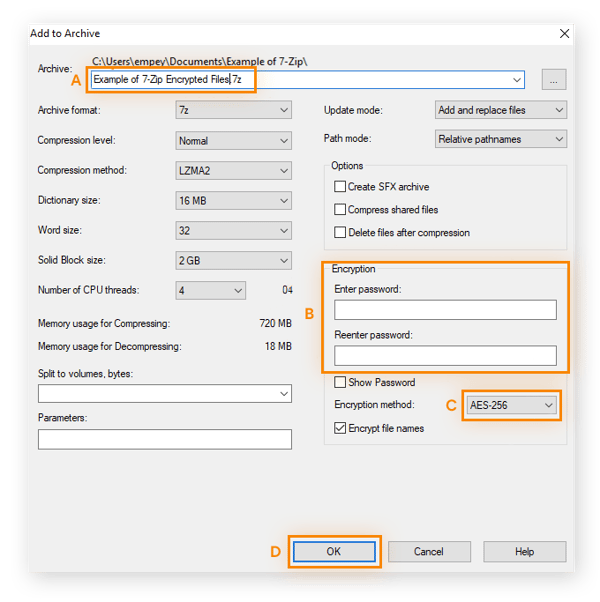
-
Your file or folder is now compressed, encrypted, and protected. Decompressing is just every bit simple:
-
From the 7-Nix control panel, select the file or folder yous'd similar to open.
-
Click the Excerpt button.
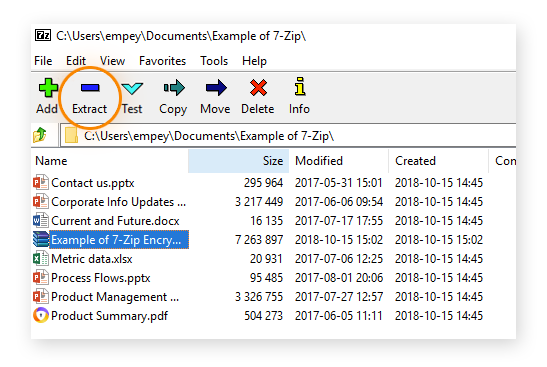
-
In the dialogue box, enter the password. Then click OK.
-
Your file or binder will decompress and open up for you.
VeraCrypt
With back up for AES, Snake, and TwoFish keys, VeraCrypt is a costless, cross-platform data security tool that can encrypt files very effectively. VeraCrypt comes with full deejay encryption but can encrypt at the book (folder) level as well. Users tin can decide whether they want specific folders encrypted or unabridged systems.
VeraCrypt may seem intimidating, just it's actually quite elementary once you become the hang of it. The software works similarly to the Daemon tools that can create a virtual CD bulldoze on your reckoner.
Download the setup file for Windows and install the software, then follow these instructions:
-
To start, you demand to create a volume, which is essentially an encrypted folder to firm your data. Click on Create Volume.
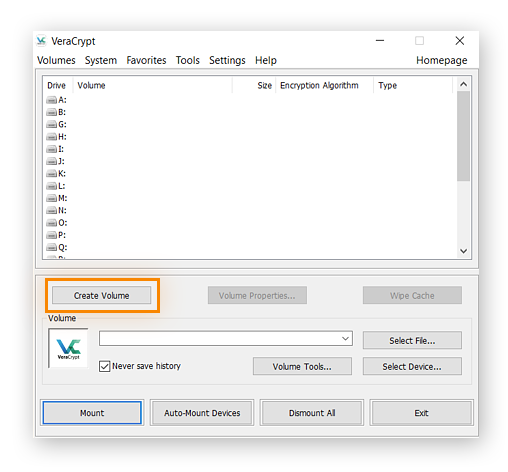
-
Select Create an encrypted file container and click Next.
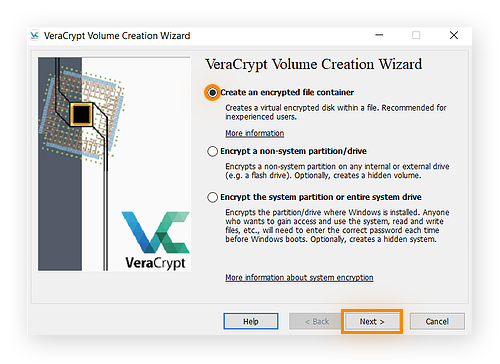
VeraCrypt lets yous create a normal, visible container or an invisible 1. For our case, we'll choose Standard VeraCrypt book, but select whichever option is best for y'all.
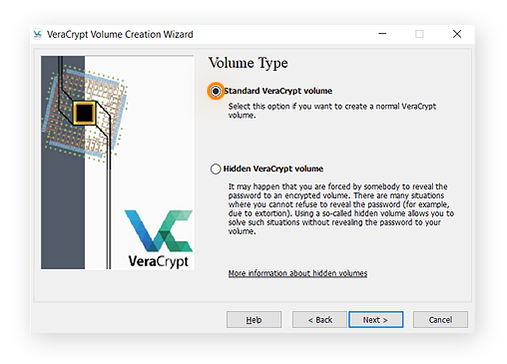
-
Click Select File and navigate to where yous want to store your encrypted container. Click Next.
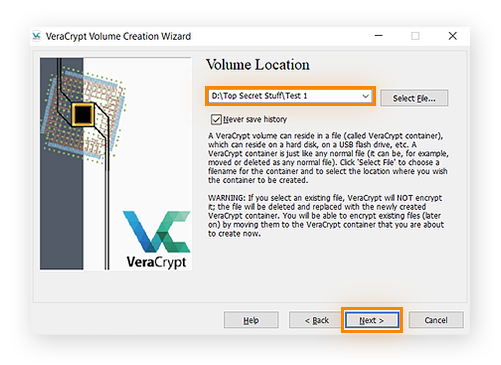
-
Now choose your preferred encryption method. Nosotros recommend AES-256, some of the strongest encryption used today. Then click Next.
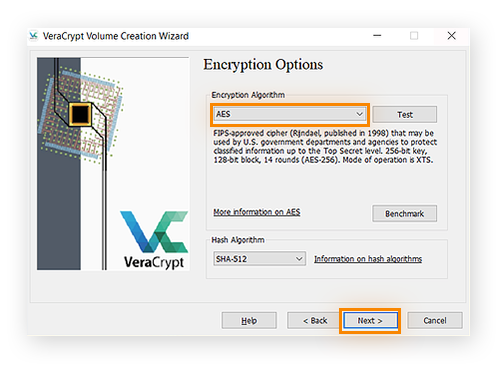
-
Note how much space you desire the encrypted folder to have. 10 MB should be plenty, only if you lot have multimedia files, you may need more than infinite.
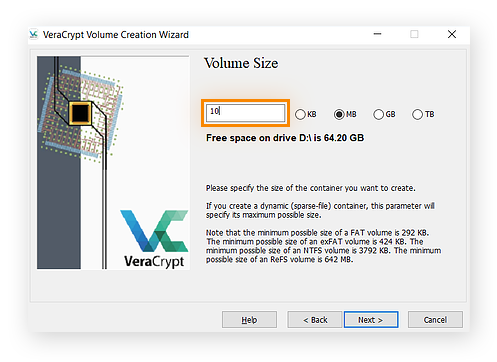
-
Finally, enter the password yous want to use for your volume (binder) and click Adjacent. Brand sure your password is stiff.
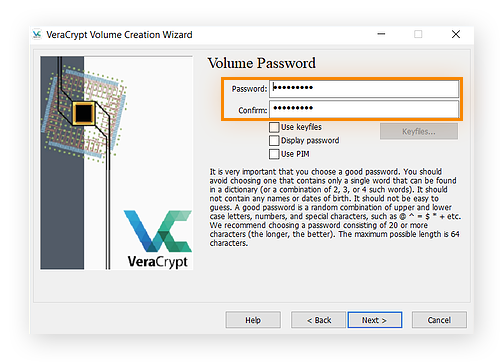
VeraCrypt is now fix to create your container. Remarkably, the tool tin utilize random mouse movements to create your encryption central and encrypt the folder. Motion your mouse around a lot because that makes the encryption key stronger — do this until the bar at the bottom reaches the end. Then click Format.
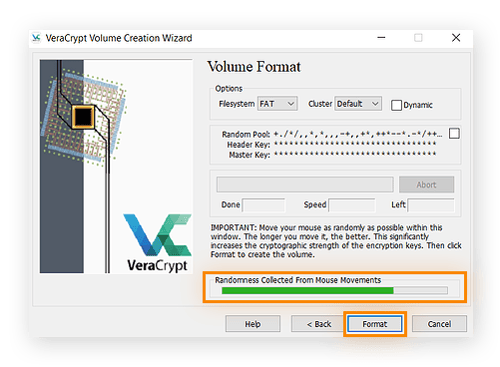
Your start encrypted volume should now be sitting in its designated folder.
To add files or folders to your encrypted container, follow these steps:
-
To mount your volume, choose a drive number from any one of the drives available on the VeraCrypt habitation screen.
-
Click on whatsoever of the letters in your highlighted volume name, click Select File, and navigate to the folder where you saved your encrypted container.
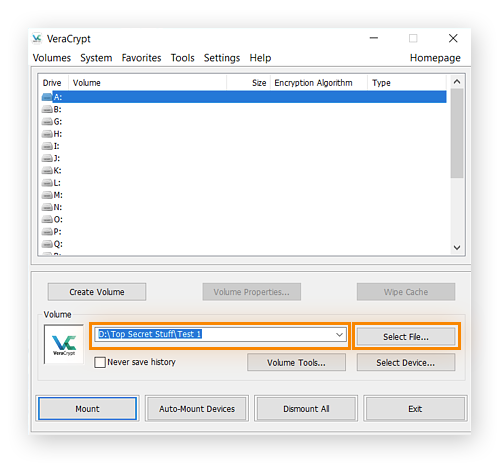
-
Click Open up to select the volume.
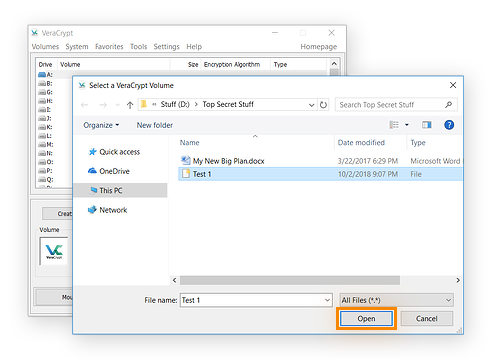
-
Adjacent, click Mount to mount the book to the selected bulldoze. Enter your password and click OK. Your container is ready.
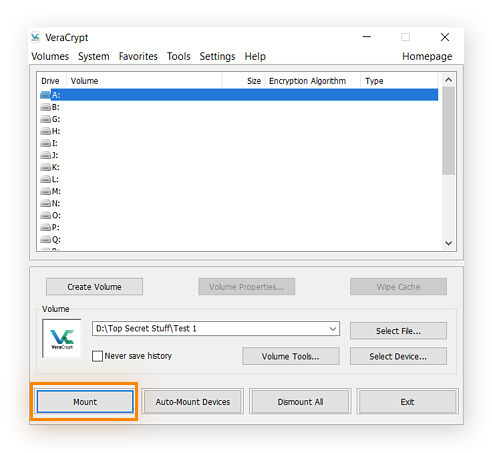
Double-click the mounted bulldoze to open another window of the container. You should also see the container in This PC along with your other drives.
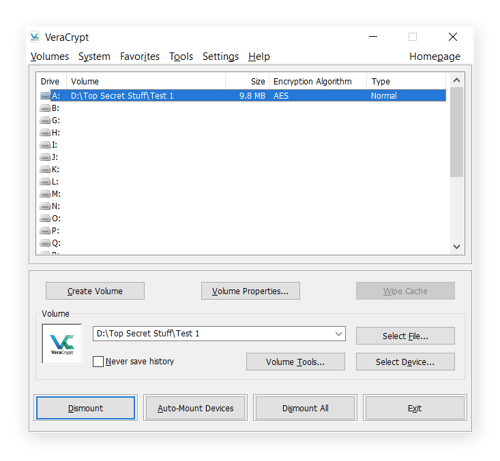
At present, copy the content to your new encrypted "bulldoze," click dismount to close the folder, and encrypt it once again.
The difference between countersign protection and encryption
Password protection is like locking something in a safe, like a highly sensitive certificate. Encryption is like rearranging all the letters in a certificate then that they tin can only exist placed back in the correct order if y'all have a special decoder key.
With password protection, knowing the password is literally the primal. That's why password protection is sometimes referred to every bit a form of noesis-based hallmark. One time y'all know how to password protect a folder, anyone who wants to access it must know the password equally well.
If you lot need a physical primal, like an actual key or a special USB bulldoze, to access a secret certificate, this would exist a form of possession-based hallmark. If the key were your fingerprint or face, you would exist using inherence-based authentication, because you lot're using something that is inherent to you and you lone. These factors are of import in 2-cistron authentication.
Encryption scrambles a document'south data and so that it looks like a wall of random characters. To access the document, you need to have a decryption key. Unencrypted documents are stored unremarkably in plaintext, and anyone tin read them.
In the case of file and folder encryption in Windows, the "fundamental" means being logged in to your account as the right user. Even on the same computer, documents encrypted by ane user are unreadable on another user account.
Countersign encryption is a third option that combines password protection and encryption. If someone has the correct password to unlock the file or folder, they still won't be able to read information technology if they're not logged in every bit the authorized user.
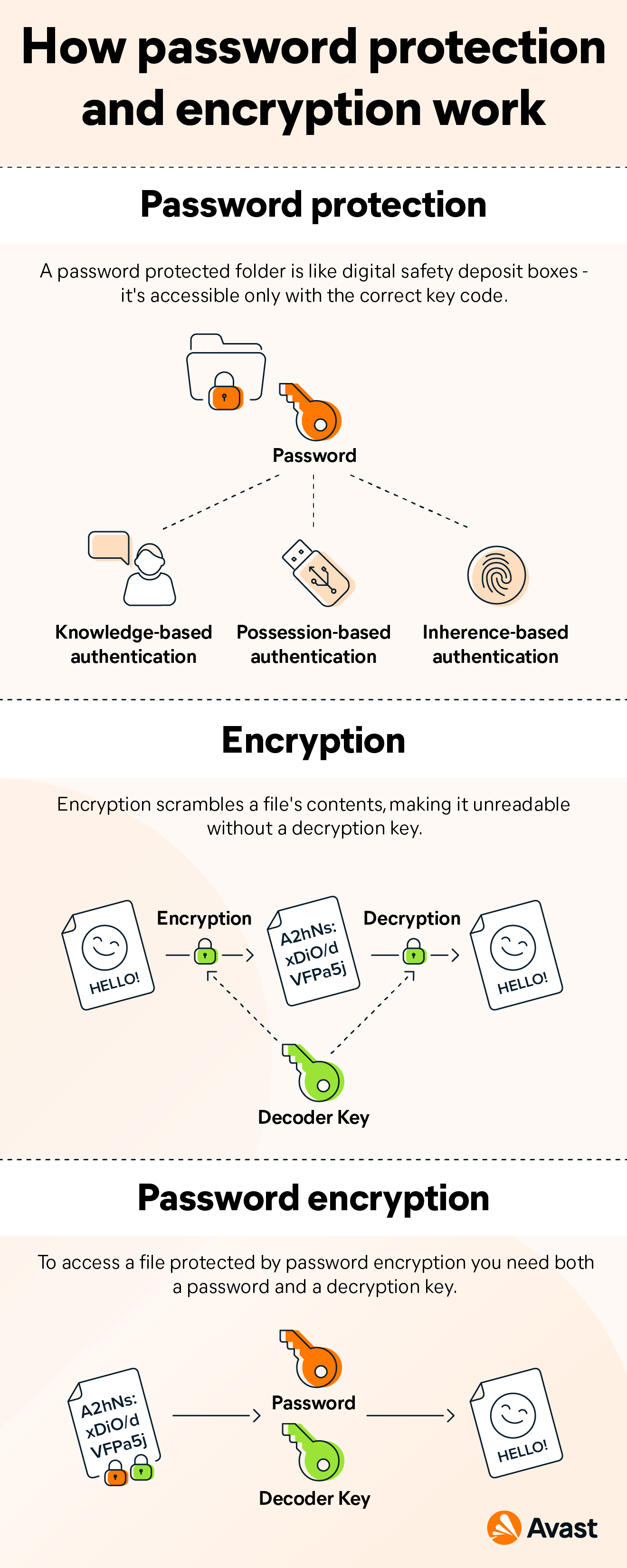
Why password protect files?
Y'all should countersign protect files because if y'all share your figurer with others, someone might accidentally delete or modify an important file, or even share a private binder. You might fifty-fifty make the disquisitional mistake yourself, accidentally sending sensitive information to the wrong person.
Sharing a computer is not a problem if you add together a password to your most sensitive files. Entering a countersign every time you lot access that file may wearisome you lot down a fleck, only the added security is worth it.
Always apply potent passwords. Avast'south free random password generator will instantly create a unique and hard-to-crack password whenever y'all need i.
And you can e'er apply Windows to encrypt an entire folder, as described above. Knowing how to countersign protect a folder and how to encrypt your files is key to making certain your content is locked upwardly tight.
Managing files and passwords
Now that you know how to password protect and encrypt your files and folders in Windows, all that'southward left is keeping your passwords safe and following good security practices.
Back up your information
Consider what might happen if you lost your chief countersign, if your encryption software got corrupted, or if the files themselves got lost. Backing up your data regularly and using a countersign manager can help ensure that never happens. You lot can even clone your entire hard bulldoze to an external storage device.
Some of the tools mentioned above, like Binder Lock, come up with their own cloud-based data backup solutions. Simply yous can use Microsoft's OneDrive or the free Google Bulldoze as well.
Create strong passwords
The biggest claiming with strong passwords is remembering them. But you're setting yourself up for potential information theft if you create one password to use beyond all of your accounts. The common culling — creating simple, like shooting fish in a barrel to remember passwords — is just as bad.
Weak and common passwords are easy to hack using programs that cycle through dissimilar key combinations at unfathomable speed. These password cracking techniques are highly advanced. In 2012, hackers created a computer cluster that guesses passwords at a charge per unit of 350 billion per second — and things have only evolved since then.
That's why long, unique, and difficult-to-approximate passwords are one of the best means to protect your files and devices against hackers.
Continue your new passwords safe and secure
Now that you've encrypted your files with unique and difficult-to-guess passwords, protect all your passwords and accounts with Avast BreachGuard. With 24/7 dark web monitoring, BreachGuard will alert you if your passwords or other personal information are ever leaked, helping you to reply ASAP and stay alee of anyone looking to compromise your accounts.
Can I Password Protect A Folder In Windows 10,
Source: https://www.avast.com/c-password-protect-file-folder-windows
Posted by: buntingaceis1940.blogspot.com


0 Response to "Can I Password Protect A Folder In Windows 10"
Post a Comment